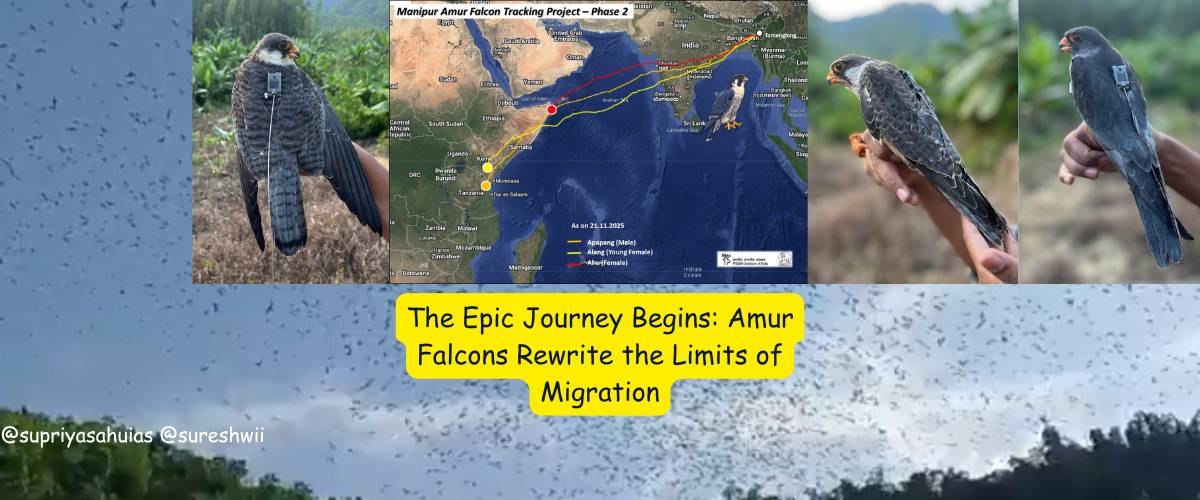Amur Falcons Stun Scientists With Record-Breaking 6,100 km Nonstop Migration: New Tracking Data Released
India — The incredible story of one of the world’s toughest migrants has unfolded once again, as three Amur Falcons tagged under the Manipur Amur Falcon Tracking Project (Phase 2) have delivered jaw-dropping migration performances across continents.
Satellite-tagged on 11 November 2025 by the Wildlife Institute of India (WII), the three falcons — Apapang (adult male, orange track), Alang (young female, yellow track), and Ahu (adult female, red track) — have already crossed the Arabian Sea and reached East Africa, reaffirming why the species is celebrated as one of nature’s greatest long-distance travellers.
The standout this season is Apapang, who completed a staggering 6,100 km in 6 days 8 hours non-stop, flying from Manipur across central India, over the vast Arabian Sea, and into Somalia before heading toward Kenya. Experts say such a continuous transoceanic flight represents one of the most demanding journeys undertaken by any raptor on the planet.
Alang, the youngest among the trio, covered 5,600 km in 6 days 14 hours with two brief halts — a night stop in Telangana and a short rest in Maharashtra — before launching into her oceanic crossing.
Ahu, steady and consistent, flew 5,100 km in 5 days 14 hours, pausing in western Bangladesh before taking a slightly shorter northerly route to Somalia.

Current tracking data shows Apapang and Alang already inside Kenya, while Ahu remains at the northern tip of Somalia, likely moving toward Tsavo National Park, a known rest stop for the species.
Sharing the update, Supriya Sahu, IAS and Dr. Suresh from the Wildlife Institute of India, who leads the tracking programme, explained that these birds—barely 150 grams—push the boundaries of physiology, instinct, and endurance. Their migration journey relies heavily on India’s protected stopover habitats, especially in Nagaland and Manipur, where the birds arrive in time for the emergence of termites. This period of intense feeding, known as hyperphagia, fuels their nonstop 3,000 km sea crossing during which they cannot land or feed.
In a short Q&A, Dr. Suresh and highlighted why tracking is critical: “Satellite tagging helps us map exact routes, identify threats, understand climate-driven changes in migration patterns, and protect crucial habitats. These insights shape conservation at a global scale.”
Migration, he added, is an evolutionary survival strategy, shaped over generations as birds adapted to seasonal food availability and breeding conditions. The Amur Falcons depend on India’s resource-rich stopover sites to build the fat reserves needed for their extreme endurance flight to Africa.
The project, widely followed on social media, continues to captivate bird enthusiasts across India. Images and updates shared by @sureshwii, @wii_india, and @supriyasahuias (Twitter) have helped turn the annual migration into a national conservation success story.
With their remarkable journey underway, the Amur Falcons once again stand as a testament to the power of instinct, wind, stamina, and survival — and to India’s rising global leadership in protecting one of the world’s most extraordinary migratory pathways.
More details and live migration map:
https://birdcount.in/migration-map/amufal1/
https://x.com/supriyasahuias/status/1992478272706556377?t=XidvLErasNTTqSVlIVIRCw&s=03
Explore more
🎤 Career – Real career stories and job profiles of life science professionals. Discover current opportunities for students and researchers.
💼 Jobs – The latest job openings and internship alerts across academia and industry.
🛠️ Services – Regulatory support, patent filing assistance, and career consulting services.




